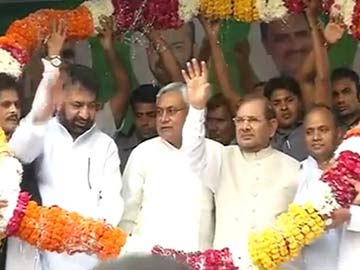New Delhi, Oct 30: Amid efforts to form a Third Front, several regional parties including Left, JD(U), AIADMK, BJD and UPA ally NCP on Wednesday came together at a convention in New Delhi with their leaders pitching for unity among them to defeat the "threat" from fascist and communal forces".
JD(U) leader and Bihar chief minister Nitish Kumar appeared to target BJP's prime ministerial candidate Narendra Modi as he said some leaders go after those who oppose their views or ideologies and talk about "cleansing" them.
Addressing the 'Convention against Communalism', he said the 17 parties assembled at the meet should forge "maximum possible unity" to defeat the threat from "fascism, communalism and terrorism" to the country.
"The question being asked is that if this convention means formation of a new front. As of today, this is not the case. But we all have to think that in the face of fascism, communalism and terrorism, democratic forces should maintain maximum possible unity on issues to combat and defeat such powers," he said.
Kumar said that in the aftermath of riots in UP's Muzaffarnagar, there has been a realization about the need to raise voice against the threat of communalism.
The convention, organized by the Left parties, is being seen as an attempt for forge a conglomerate of non-Congress and non-BJP parties ahead of the 2014 Lok Sabha elections.
SP chief Mulayam Singh Yadav, whose party is in power in Uttar Pradesh, said Muzaffarnagar riots were fomented by communal forces.
"At least we got together (on the same platform). If we unite, communal forces will not able to raise their head ... We have crushed communal forces and we will continue to crush communal forces whenever they rear there head again," he said.
Yadav's colleague Ram Gopal Yadav said on Wednesday's meeting was a "beginning" for the shape of things to come in the future.
NCP leader Praful Patel justified the party's participation in the convention, saying "in the era of coalition politics, we have to keep our options open of working with other parties."





Comments
Add new comment